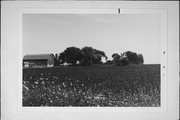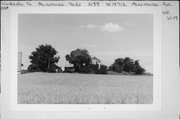| Additional Information: | Description:
Of uncoursed rubble construction, the Jacob Gilman Farmhouse [A, B] exhibits Greek Revival styled details, including large, wooden cornices and cornice returns, arched four-over-four windows and a fan-shaped window in the street-facing gable end. The dwelling also has a wooden, gable-roofed west addition and the remnants of an open porch in the front angle of the house. The residence, which was built before 1859, is presently in deteriorating condition. A barn is related to this farmhouse, but there is no corresponding photo for the structure.
Once part of a 236 acre farm owned by Phillip Hoffman in the late 19th century, the Gilman House, along with its attending barn structure, is located on 75.28 acres of uncultivated farmland. [B].
Architectural/Engineering Significance:
The Jacob Gilman House is not architecturally significant because the house is in deteriorating condition, and other better preserved examples of a Greek Revival styled farmhouse of stone construction are included in the survey of Menomonee Falls.
Historical Background:
Jacob Gilman received the 160 acre original land grant to his property in 1846. His farmhouse appears on the 1859 map. Gilman sold the property to Phillip Hoffman in 1867. By 1880, Hoffman had expanded his holdings to 236 acres. He retained the farm until the early 1900's. Paul Schneider gained ownership prior to 1910. It later passed to Peter Schneider, who owned it in 1940. [1, 2, 3, 4].
A New York farmer, Gilman worked 40 of his 160 acres by 1850. The agricultural census lists a minimal production level: 150 bushels of corn, 120 bushels of oats, 75 pounds of butter from a single cow, and two oxen, presumably for breaking the sod. By 1860, Gilman, on 90 imporved acres, still produced wheat (175 bushels), but also continued to expand his dairying operation, producing 300 pounds of butter and maintaining 26 sheep, which produced 8.5 pounds of wool. [6]. Gilman clearly followed agricultural trends maintained by other Yankee farmers in southern Wisconsin, who had by the 1860's began to shift from wheat production to dairying and sheep raising. [7, 8].
Born in 1831 at sea en route from Alsaece, Phillip Hoffman was categorized as a Prussian by later census takers. The 1870 agricultural census reflects his activity on his property. Then working 100 improved acres, Hoffman raised 500 bushels of wheat, 400 bushels of oats, other monor crops, 5 milk cows, and 22 sheep. From his milk, he produced 100 pounds of butter and 60 pounds of wool. [6]. Hoffman did not maintain the level of butter and wool production shown by Gilman, but dramatically increased his wheat output on 10 more acres of land. He appeared to follow trends set by other German farmers in the area. Rather than increasingly emphasizing dairying and sheep, he also continued to stress wheat production. [7,8]. Phillip Hoffman was associated with this farmhouse from 1899 to 1910. [2, 3].
Historical Significance:
The Gilman/Hoffman residence now lacks historical significance because the farmhouse is in deteriorating condition. |
|---|
| Bibliographic References: | Architectural References:
A. Waukesha County Wall Map, Town of Menomonee, Wisconsin, (1859).
B. Tax Records, Town of Menomonee, 1849-1955, Area Research Library, University of Wisconsin - Milwaukee, Wisconsin.
Historical References:
1. Walling, 1859.
2. Waukesha County (Abstract of Title), 1846, 1867.
3. Waukesha County (Tax Assessment Records), 1880, 1910, 1940.
4. Wright, A. G., 1899: 231.
5. United States, Department of the Interior, Census Office (Population Schedule), 1850: 1860; and 1870.
6. United States, Department of the Interior, Census Office (Agricultural Schedule), 1850; 1860; and 1870.
7. Perkins, 1984: 181-82, 190-95.
8. Nesbit, 1973: 283-85. |
|---|


